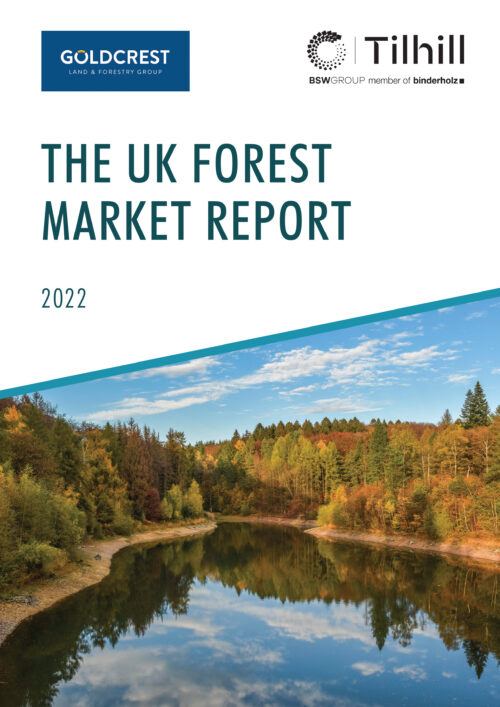The natural capital market has continued to develop in 2022, with a number of large estates coming to market during the year, particularly in Scotland. These properties typically offer scope for substantial native woodland planting often combined with large-scale peatland restoration. In some cases, there is also potential for tree planting for timber production.
Properties which afford the opportunity to benefit from all three of these activities in a single project can be very attractive to investors and may mean that a higher proportion of the asset can become revenue-generating as compared to some more traditional forestry investments relying solely on timber income.
The carbon markets, built on carbon sequestration in native trees and carbon emissions reduction through peatland restoration, have added value to these properties and persuaded their owners now is a good time to sell. With many analysts predicting much higher future prices for carbon credits, this trend of increasing land supply to the market may continue for some time yet.
Natural Capital Opportunities
We have tracked natural capital opportunities closely this year. The market is sizeable and includes land that is suitable for only native tree planting due to access restrictions or designations such as national parks. It further includes peat, though not necessarily eligible for restoration. Finally, it includes farmland that is not arable and is also unsuitable for tree planting or peatland restoration, but may be suitable for nature restoration, biodiversity net gain or rewilding.
The market has a broader specification than that of commercial planting land, and hence is larger. £80.7m of opportunities totalling 6,900 hectares have been listed for sale across the UK in the past year. This excludes 3,000 hectares of crofted grazing that otherwise skews figures. England is the largest market with £32.4m of listings across 2,500 hectares, followed by Wales with £28.9m across 2,100 hectares and Scotland with £19.5m across 2,300 hectares.
The total areas are similar across the countries, but Scottish properties are around double the size of those in England and Wales. Prices per gross hectare are similar in England and Wales at £13,200 and £13,600, respectively. Neither number is far from the commercial planting land values, showing that in some cases, land for planting native species for carbon isn’t necessarily cheaper than for planting commercial. In Scotland the price is just £8,500 per hectare, showing how much the suitability for commercial forestry raises land prices north of the border.
The Carbon Codes
The Woodland Carbon Code (WCC) has been with us for just over 10 years now and over the past few years there has been a noticeable rise in new plantings being registered under the code. This rise is illustrated by figures provided by WCC. As of June 2022, there were 387 validated projects amounting to 20,800 hectares, compared with 1253 projects and 40,900 hectares under development.
The Peatland Code (PC), which launched in 2015, is following a similar trend, albeit from a lower base. We are seeing interest in peatland restoration ramping up and new project registrations are rapidly increasing. By February of 2022, IUCN UK Committee, which oversees the PC, reported a total of 79 registered projects and 10,300 hectares of expected peatland restoration. Of these, only 11 projects or 1,600 hectares have progressed as far as validation.
Peatland Restoration
It is probably fair to say that restoring peatlands can involve more complex operations than tree-planting and to some extent is still experimental. However, early projects have
served to improve understanding of all aspects of these operations. A great deal has been learned and over time the resource base will build to increase capacity. With this will come greater market confidence and we can expect the upward trends to continue.
Scotland alone has set aside £250m for peatland restoration over 10 years. Assuming an average restoration cost of around £5,000 per hectare and a contribution of at least 15% from carbon finance (the additionality hurdle rate), there are sufficient funds to restore a little under 60,000 hectares. Given that 25,000 hectares are already in development under the grant scheme and there is a total of 1.5m hectares of peat in Scotland, there is likely to be a funding gap as more projects come forward.

The funding gap for peatland restoration applies equally to other areas of nature recovery and in October 2021, the Green Finance Institute (GFI) published a report titled ‘The Finance Gap for UK Nature’. The headline figure in the report is an estimated UK-wide funding gap of somewhere between £44bn and £97bn required for nature-related outcomes in the 10 years from 2022-2032.
Expected outcomes are based on existing public policy and include clean water, protection/restoration of biodiversity, flood risk reduction, enhanced biosecurity and climate mitigation through bio-carbon. Taking the example of peat restoration, the report estimates a required spend of £920m to meet stated government targets, with a committed spend of £360m, leaving a shortfall of £560m.
Funding in the Sector
While the lack of necessary funding is very evident, equally there are many in the investment sector looking for opportunities to invest in nature-based solutions at scale. This has been recognised by an important follow-up to the GFI report, ‘Financing Nature Recovery UK – Scaling up High-Integrity Environmental Markets across the UK’, published by the GFI in collaboration with Finance Earth and Broadway Initiative.
This report acknowledges that public funding and philanthropy cannot be relied upon to deliver our environmental commitments and recommends a set of reforms to ‘catalyse private investment to fill the annual £5.6bn financing gap for UK nature’.
Meanwhile, Tilhill has been increasingly involved in a wide array of natural capital projects, at scales of 20-30 hectares and upwards. These are primarily focused on native tree planting and/or peatland restoration but clients are now often asking us about the potential for other types of nature recovery projects.
Tangible Opportunities
Despite the tangible opportunities now offered by carbon income, one feature of many of the properties coming to market over the past year is that while they tend to offer carbon
finance opportunities for planting and peatland restoration, there are frequently substantial areas of ground that offer no obvious avenues for improved returns over traditional activities such a grazing or sporting.
In some cases, it appears as though there are signs of investor speculation that nature finance will offer new revenue opportunities for landowners in the coming years, as the necessary pipeline is built which connects large-scale private finance with nature-related benefits on the ground. Land- banking may become a more prominent feature of the market over the next few years as new markets for ecosystem services are established.
The UK Forest Market Report
This article is from the 2022 edition of ‘The UK Forest Market Report’. The annual UK Forest Market Report (FMR) produced by Tilhill, provides an in-depth study of the UK commercial forestry and woodland investment market, from the perspective of both buyers and sellers.

The UK Forest Market Report
Find out moreJoin Us for the UK Forest Market Report 2023 Launch Event
The annual UK Forest Market Report (FMR) produced by Tilhill, provides a study of the UK commercial forestry and woodland investment market, from the perspective of both buyers and sellers.




